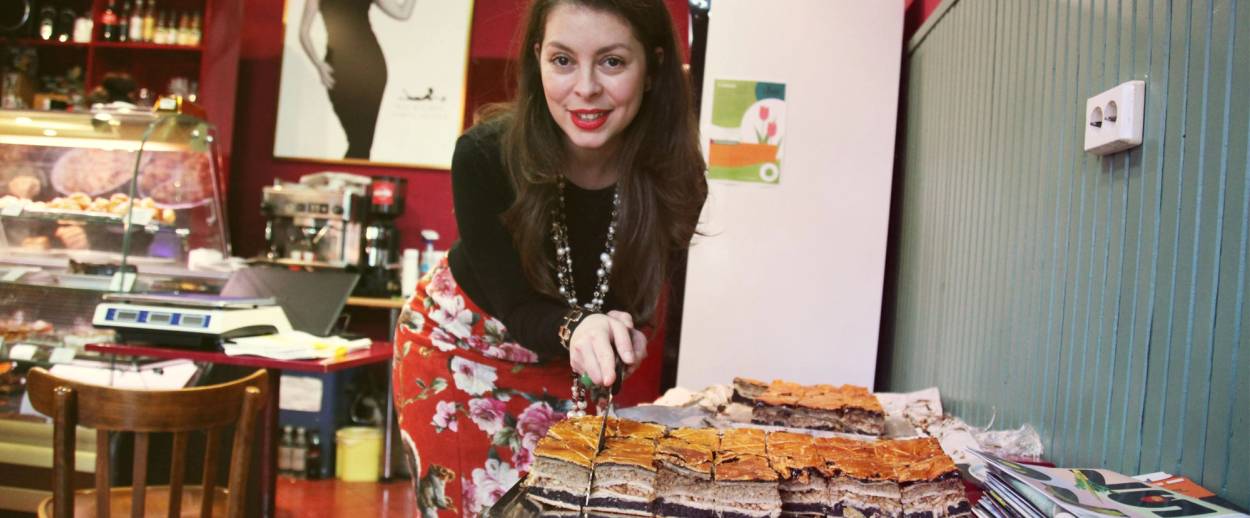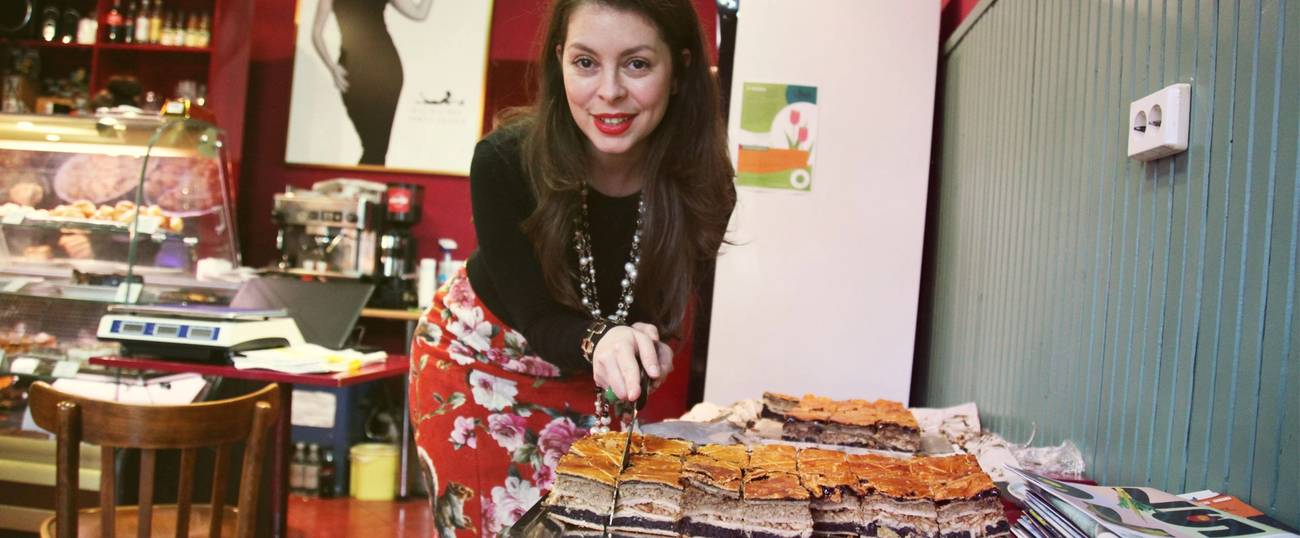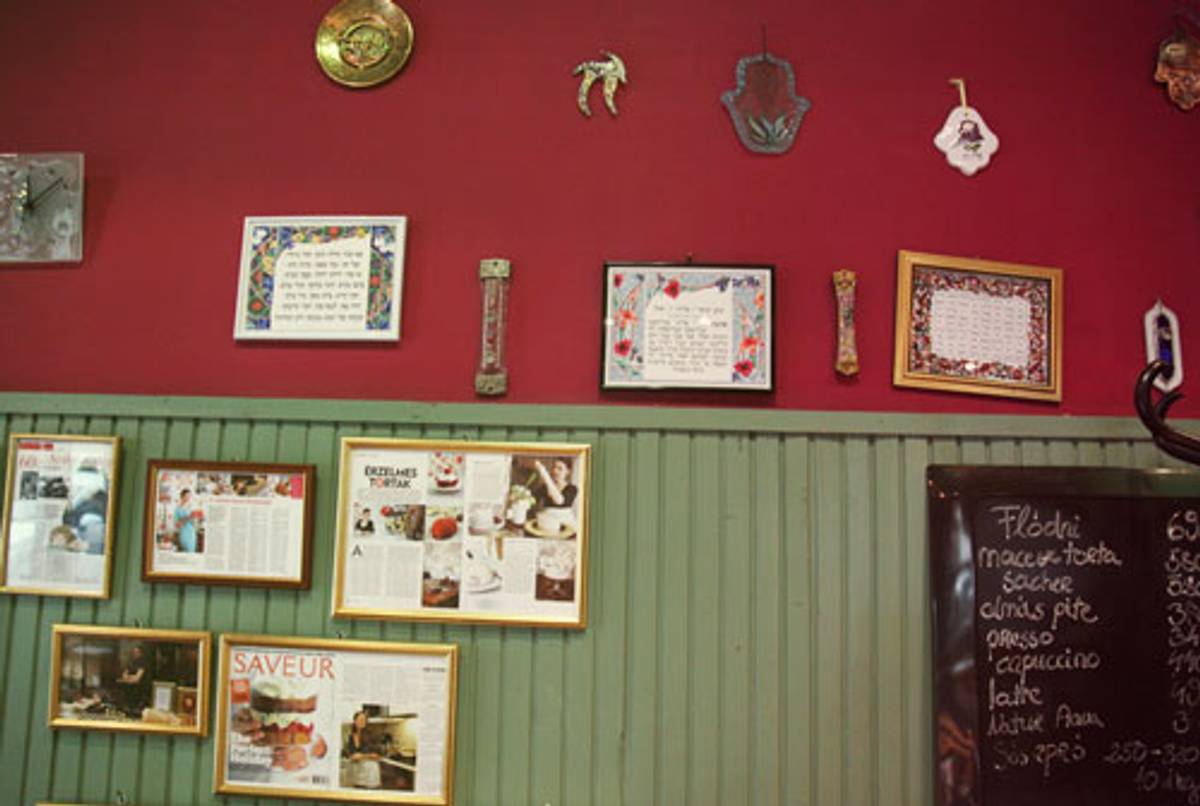Budapest’s Top Pastry Chef Gives Christmas a Jewish Flavor
Rachel Raj’s flodni—a layer cake filled with fruit, nuts, and poppy seeds—has made her a household name across Hungary




Among the wooden shacks filled with hot cherry wine and chunky goulash soup in Budapest’s Vörösmarty Square Christmas Market, one stands out: It belongs to Rachel Raj, named Hungary’s Pastry Chef of the Year by Budapest Week magazine, and she’s using it to sell flodni, an elaborate layer cake filled with plum, apple, poppy seeds, and walnut—a traditionally Jewish Hungarian dessert based on a recipe she inherited from her family. (Recipe here.)
“Think about how much the winter taste the flodni has,” Raj said. “Do you know how many people take home flodni for Christmas?”
Raj built her reputation on Jewish cakes, but gradually branched out to become a fixture on the Budapest baking community. Many people, including deli historian David Sax, have compared her to America’s Rachael Ray—and not just because their names are similar. Raj has been on countless TV programs, including CNN’s Anthony Bourdain: Parts Unknown. Last year she mounted an exhibition of paintings made out of carefully cut and colored marzipan in Budapest’s Museum of Applied Arts.
Raj has never met Rachael Ray—although she’s heard the comparison. But there are important differences: While the American Ray is a loud, vivacious proponent of easy home cooking, the Hungarian Raj is more concerned with precision, resurrecting traditional recipes, and communicating the Jewish world to Hungarians.
***
Visiting Budapest ahead of Christmas season offered a peek into her world and into Hungary’s burgeoning upscale food scene.
In late November, Raj took the stage of the second annual SütniCake Pastry and Cake Festival, in Budapest. About 100 people milled around stands hawking cotton candy, tea, marzipan, macarons, cake-decorating equipment, and fondant. While her husband Miklos Maloschik ran interference with their two sons—Natan and Leo, both skilled at squeezing the 2-inch-high flodni into their small mouths—Raj worked with two aspiring pastry chefs. First she showed them how to roll out and cut bits of colored marzipan to “paint”—in this case, a sketch of a Christian Louboutin shoe—as an edible piece of art. Then she walked with one, Martin Farkas, to a table loaded with teetering confections competing for the title of best circus-themed cake. Farkas’ cake, themed to look like a freak show, popped with bright colors on a clock and clown face—except for beige flowers.
“I love this,” she said. “Such beautiful details. So, I thought you shouldn’t let the flowers be plain.”
“I think she is right,” said Farkas, a high-school student who taught himself cake decoration from Internet videos.
Raj wore gold Chanel earrings, a chunky pearl necklace over a black shirt, and a tight floral red skirt—before she became a baker she studied fashion design. While she was a student, however, she helped her mother sell cakes in the Café Noe coffeeshop adjacent to her mother’s Biblical World Judaica store, where Raj’s father, the late Rabbi Tamas Raj, would deliver lectures among the books. With time, Rachel got more involved in selling, and the store grew.
“So, I was there, selling a lot and studying to be a fashion designer, something I loved,” she said. “And it turned out the business with the cake was going well, we needed a bigger place, and by then I was so deep inside that the next shop we opened was in my colors, with my ideas.”

At the new shop, Tortaszalon (Cake Salon), Raj used paintings and Art Deco posters from her fashion design courses as inspiration for her intricately decorated cakes in Budapest’s Fifth District. At the same time, Raj took over Café Noe from her mother, where she continued serving classics of the Jewish kitchen—like flodni.
She got her the first TV appearance nine years ago, when the show Taste Hunter on Hungarian TV2 featured her flodni. The following year she starred in a 10-part series on the Jewish kitchen for Hungary’s food network, TV Paprika.
Raj continued making custom-order cakes and flodni, but her husband—whom she met when he was a customer at her bakery—had bigger plans. He had been a fashion designer and worked in hotels in England and Kenya and was enrolled in an MBA at Budapest’s Oxford Brookes University.
“I thought, why don’t we make world record of flodni? Because Rachel has such a fantastic thing,” he said. “And we checked around the world and they said there was no world record in flodni. And I checked all the conditions. And we got a lawyer and everything.”
In the summer of 2012, they laid 1,600 pieces of flodni on tables at the Sziget Festival, one of the largest musical festivals in Europe, held in August in northern Budapest. Raj spoke to the grungy festivalgoers while wearing her signature Chanel earrings and fire-engine-red lipstick. The announcer of the event said, “The average flodni is 6 centimeters high. If we would stack these all up it would be 96 meters.”
“As high as the Hungarian parliament!” Raj said.
Today, Raj runs three cake shops. Her most recently opened one is in her mother’s former Kabbalah shop. Her mother continues to run the original Judaica shop in Budapest’s Jewish district. The walls are plastered with framed magazine spreads featuring her cakes, right underneath hamsas and Jewish paintings.
***
Before WWII, Budapest was one-quarter Jewish. Even after 600,000 Hungarian Jews perished in the Holocaust, a thick line of Yiddish DNA still courses through Hungarian cooking. Raj said her father’s family was among the half of Budapest’s Jews who survived the war by staying in “safe houses,” which were properties designated by the Swedish government to be under their protection.
Now the area around the striped brick Dohany Street Synagogue, Europe’s largest, is once again alive with Jewish businesses, from a kosher salami maker to the award-winning Rosenstein’s restaurant that serves up goose gribenes, to the kosher Tel Aviv Café.
Regina Papp, co-founder and editor of the website Welovebudapest.com, said Raj is a pillar of the Jewish neighborhood. “If you go to any kind of Jewish or kosher restaurant, for sure the flodni is coming from Rachel,” she said. “In the Jewish district she is always there in the opening parties and making speeches about Jewish culture.”
Raj admits to being “surprised” at how much Hungarians have embraced Jewish food and culture. “My daddy said the best way against anti-Semitism is to get to know what [Judaism] is,” she said. “And with flodni and TV and Jewish gastronomy, I think I have the best way to show and get love for this religion.”
Hungarian food TV-show host, food writer, and cookbook author Zsofia Mautner said Raj is a “celebrity to the Jews,” but also part of a new wave of back-to-the roots Hungarian cooking. “In 2007, a Culinary Charter has been signed by a number of chefs, restaurateurs, [and] food writers, promoting the renewal of Hungarian cuisine,” Mautner wrote in an email, noting a new focus on freshly prepared food using local ingredients. “It all started in fine dining and continued year by year with opening of new generation bistros, pastry shops, and street food markets.”
Raj’s career has expanded in sync with this increased attention to Hungarian cuisine. Budapest’s Costes restaurant garnered the country’s first Michelin star in 2010. Since then another three eateries have made the list.
“Hungary’s windows opened up more and more to the world,” Raj said. “Especially after the Soviet Union, everything was closed down. Our generation was open-minded and wanted to learn more about food. It’s working.”
***
Like this article? Sign up for our Daily Digest to get Tablet Magazine’s new content in your inbox each morning.
Daniella Cheslow is an American journalist covering the Middle East.
5 cups flour
1 1/8 cups margarine
3 egg yolks
Scant cup of red wine
2.2 lbs apples, peeled, cored and grated
7 oz ground walnuts (about 1.75 cups)
7 oz ground poppy seeds (about 1.5 cups)
1 jar of plum jam, about 2.5 cups
1 cup raisins
2 tablespoons apricot jam
1 tsp ground cinnamon
A pinch of ground cloves
3 tsp grated orange zest
1. Make the dough: Mix the flour, margarine, 2 egg yolks, a pinch of sugar and a splash of wine, to taste. Knead dough until it can be easily worked. Divide the dough into five parts, with one slightly larger than the rest. Refrigerate until the fillings are made.
2. Make the poppy filling: Mix the ground poppy seeds, apricot jam, 1 tsp orange peel, cloves, with half the wine, sugar and raisins.
3. Make the walnut filling: Mix the ground walnuts, 1 tsp orange zest, and the other half of the wine, sugar and raisins.
4. Make the apple filling: mix the grated apples with the cinnamon and 1 tsp orange zest.
5. Roll out the largest piece of dough to be slightly larger than a 12”x16” baking pan with sides at least 3” high.
6. Grease the pan with margarine and lay this first sheet of dough on the bottom.
7. Spread the poppy seed filling on the first layer of dough.
8. Roll out and lay down the next layer of dough, and top it with the apple filling.
9. Roll out and lay down the next layer of dough and spread it with walnut filling.
10. Roll out and lay down the next layer of dough and spread it with plum jam.
11. Roll out and lay down the final layer of dough and brush the remaining 1 egg yolk on top.
12. Bake the flodni at 350 degrees for about hour until it is golden brown. Let cool and slice into 3-inch by 2-inch squares.
Daniella Cheslow is an American journalist covering the Middle East.